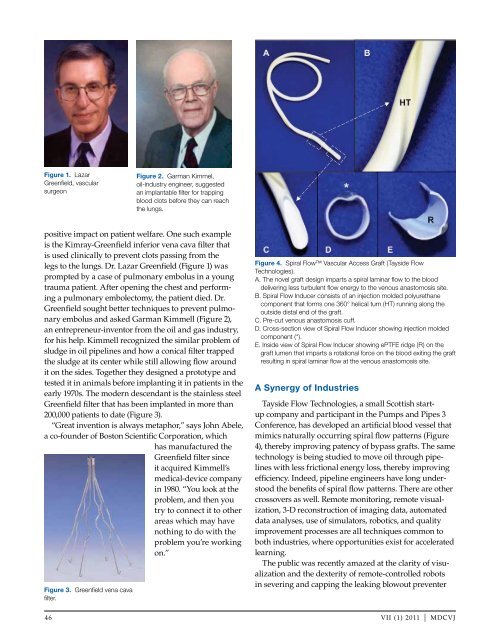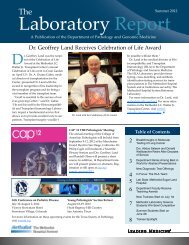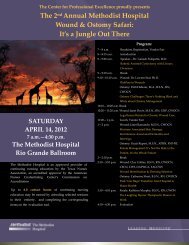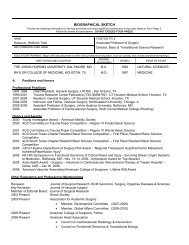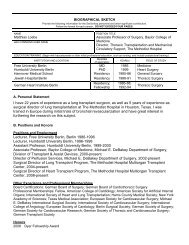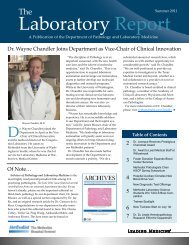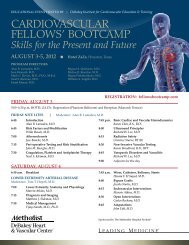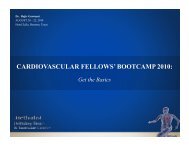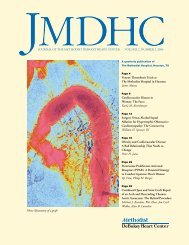DeBAKEy CARDIOvASCuLAR JOuRNAL - Methodist Hospital
DeBAKEy CARDIOvASCuLAR JOuRNAL - Methodist Hospital
DeBAKEy CARDIOvASCuLAR JOuRNAL - Methodist Hospital
You also want an ePaper? Increase the reach of your titles
YUMPU automatically turns print PDFs into web optimized ePapers that Google loves.
Figure 1. Lazar<br />
Greenfield, vascular<br />
surgeon<br />
positive impact on patient welfare. One such example<br />
is the Kimray-Greenfield inferior vena cava filter that<br />
is used clinically to prevent clots passing from the<br />
legs to the lungs. Dr. Lazar Greenfield (Figure 1) was<br />
prompted by a case of pulmonary embolus in a young<br />
trauma patient. After opening the chest and performing<br />
a pulmonary embolectomy, the patient died. Dr.<br />
Greenfield sought better techniques to prevent pulmonary<br />
embolus and asked Garman Kimmell (Figure 2),<br />
an entrepreneur-inventor from the oil and gas industry,<br />
for his help. Kimmell recognized the similar problem of<br />
sludge in oil pipelines and how a conical filter trapped<br />
the sludge at its center while still allowing flow around<br />
it on the sides. Together they designed a prototype and<br />
tested it in animals before implanting it in patients in the<br />
early 1970s. The modern descendant is the stainless steel<br />
Greenfield filter that has been implanted in more than<br />
200,000 patients to date (Figure 3).<br />
“Great invention is always metaphor,” says John Abele,<br />
a co-founder of Boston Scientific Corporation, which<br />
has manufactured the<br />
Greenfield filter since<br />
it acquired Kimmell’s<br />
medical-device company<br />
in 1980. “you look at the<br />
problem, and then you<br />
try to connect it to other<br />
areas which may have<br />
nothing to do with the<br />
problem you’re working<br />
on.”<br />
Figure 3. Greenfield vena cava<br />
filter.<br />
Figure 2. Garman Kimmel,<br />
oil-industry engineer, suggested<br />
an implantable filter for trapping<br />
blood clots before they can reach<br />
the lungs.<br />
Figure 4. Spiral Flow Vascular Access Graft (Tayside Flow<br />
Technologies).<br />
A. The novel graft design imparts a spiral laminar flow to the blood<br />
delivering less turbulent flow energy to the venous anastomosis site.<br />
B. Spiral Flow Inducer consists of an injection molded polyurethane<br />
component that forms one 360° helical turn (HT) running along the<br />
outside distal end of the graft.<br />
C. Pre-cut venous anastomosis cuff.<br />
D. Cross-section view of Spiral Flow Inducer showing injection molded<br />
component (*).<br />
E. Inside view of Spiral Flow Inducer showing ePTFE ridge (R) on the<br />
graft lumen that imparts a rotational force on the blood exiting the graft<br />
resulting in spiral laminar flow at the venous anastomosis site.<br />
A Synergy of Industries<br />
Tayside Flow Technologies, a small Scottish startup<br />
company and participant in the Pumps and Pipes 3<br />
Conference, has developed an artificial blood vessel that<br />
mimics naturally occurring spiral flow patterns (Figure<br />
4), thereby improving patency of bypass grafts. The same<br />
technology is being studied to move oil through pipelines<br />
with less frictional energy loss, thereby improving<br />
efficiency. Indeed, pipeline engineers have long understood<br />
the benefits of spiral flow patterns. There are other<br />
crossovers as well. Remote monitoring, remote visualization,<br />
3-D reconstruction of imaging data, automated<br />
data analyses, use of simulators, robotics, and quality<br />
improvement processes are all techniques common to<br />
both industries, where opportunities exist for accelerated<br />
learning.<br />
The public was recently amazed at the clarity of visualization<br />
and the dexterity of remote-controlled robots<br />
in severing and capping the leaking blowout preventer<br />
46 vII (1) 2011 | MDCvJ


